| File: | pFuel.html |
| Projects: | |
| Authors: | Remi Ricard (papaDoc@videotron.ca) and John Kern |
| Contributors: | Oscar X. Beiro, Adrian de los Santos, Fernando Deambrosio, Sven DeTroch, Thomas Arendsen Hein, John Kern, Stefan Kursawe, Michael Maier, Macello Majonchi and many others |
| Created | 21 Jun 2004 |
| Last Revision | $Date: 2005/06/29 12:57:58 $ |
| |
| Description: | |
| Revision | $Revision: 1.15.2.2 $ |
Contents
Need Palm OS 3.5 or better
| Main form |

|
| Main Form with Record Menu |
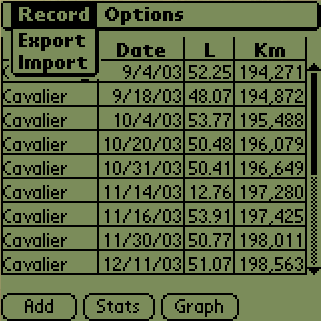
|
The records menu allows you to do two things: export fuel data to
MemoPad and import from MemoPad.
| The export form |

|
You can export your data to Memo Pad in a CSV(comma separated
value) format. This may be handy if you want to further process the
information in a spreadsheet or database. The exported records are
the ones from the current category (i.e. the record you see in the
table). If you have multiple cars represented as categories, you can
export everything by selecting the All category before exporting it.
You can also filter (Figure Export with Filter)
the data to be exported by tapping the filter checkbox. When the filter is checked
only the records with Date between the two limits will be exported.
| The export form with filter set |
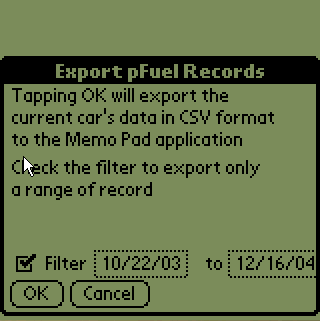
|
Here is an example of data written out by the export process.
| Data written out by the export process |
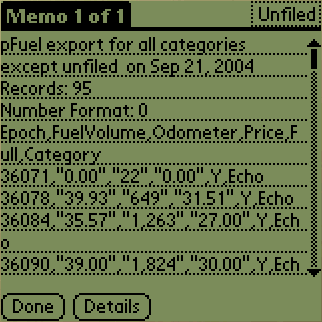
|
Importing is simply the inverse of exporting the data. It parses fuel
data in a Memo Pad record and populates the pFuel DB with the
corresponding records. The records are imported in the current category.
All MemoPad records are checked to see if there are pFuel records to
be imported. A check is done with the first line of the
record. If this line is the same as the first line of the record in
Figure
Data written out by the export proces then
the record is parsed. This implies that all MemoPad record with the given
first line will be imported.
- Header information includes
- the number of fuel records.
- the user preference for the number format which is ignored at this time.
Parsing the date back into pFuel poses some challenges. Globally
there are many variations of order(month/day/year or day/month/year),
delimits(eg, backslash, comma or period) and should it be written
short or long format.
To avoid this problems, the date is written out as the number of days
from January 1, 1904. This is the epoch on Palm OS.
| Main Form with Options Menu |
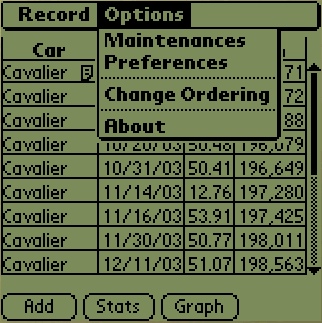
|
- Maintenances
-
This will send you to the Maintenancess Form
- Preferences
-
This will send you to the Preferences Form
- Change ordering
-
By default the ordering of the table in the Main form is in chronological
order. If you select this entry then the ordering will be inverted. The
first item in the table will be the more recent one.
This item work has a toggle. You always invert the current ordering.
- About
-
This selection will give you the information about this software.
The version number and the site where you can report bug, have new version, etc.
| Maintenances Form |
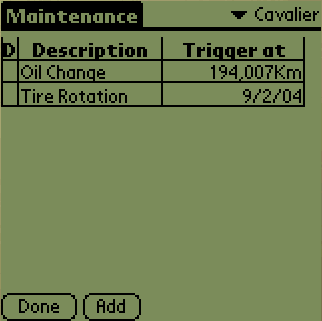
|
- Fisrt Column
-
The first column labelled "D" or done. Can have a check mark in it.
If there is a check mark then the Maintenance item is considered has done and
this item can't produce an alert.
- Second Column
-
This column gives you the description of the maintenance item. The description can
ahve a maximum of 16 characters.
- Third column
-
This is the most interesting column. It gives you when the next alert will
popup.
If the date and the Odometer value was selected the one displayed will be the
odometer value.
The ordering in the Maintenance table is done as follow.
Records with Odometer value are first (the smallest value at the top
of the table) then comes the records with Date starting with the
oldest one and going down with the more recent ones.
If you change the ordering (Fig.
Option Menu) the everything is the
other way around
| Adding Maintenance (Basic) |
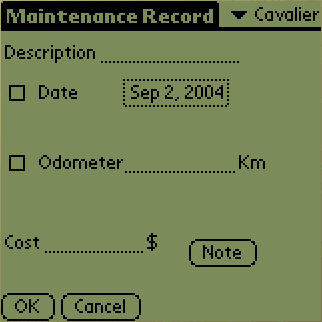
|
| Adding Maintenance (Recurrent) |
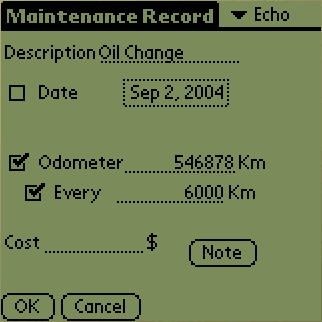
|
| Maintenance Alert |
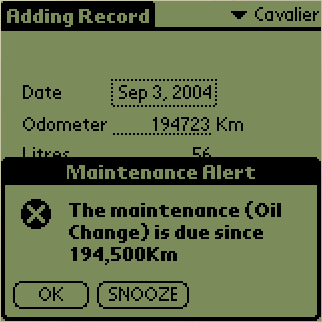
|
A Maintenance Alert will show up after
adding or modifying a Fuel RECORD. If the odometer value in
the record is greater than the one in the Maintenance
RECORD. The Fuel RECORD odometer value is checked againts
all the Maintenance RECORDS that are active (i.e. not Done).
You have 3 choices,
- OK
- You can click on the OK button. The
Maintenance RECORD will be set as done and no more warning
comming from this record will so up.
If the alert was comming from a RECORD with Every xxx selected
then a record is created with the odometer value as the current odometer and
the date as the today date. The new record is set as done and the internal
counter for the RECORD with Every xxx is incremented by one.
- SNOOZE
- You can click on the SNOOZE button and the alert will show up
again when a new pFuel RECORD will be added.
If the alert was comming from a RECORD with Every xxx selected
then a new record is created with the odometer value as one the generating
The internal counter for the RECORD with Every xxx is incremented by
one so the new record will be generating the next time a fuel record is
saved.
- GO TO
- You go to the record generating the alert.
| Preferences Form |
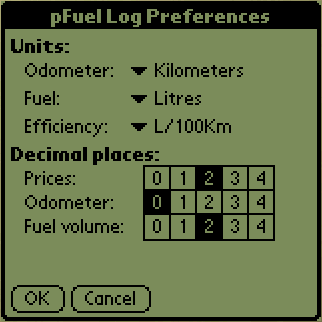
|
| Preference Form with Efficiency choice displayed |
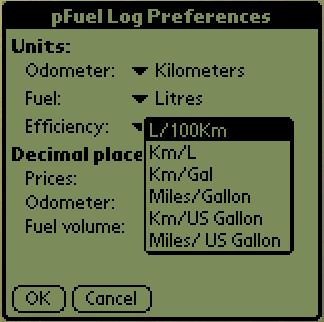
|
| Form for adding a record |
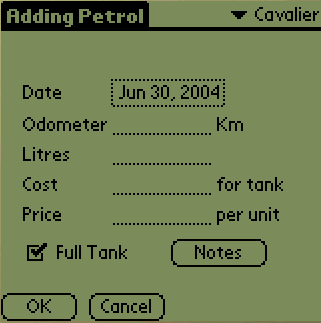
|
| Form for editting a record |
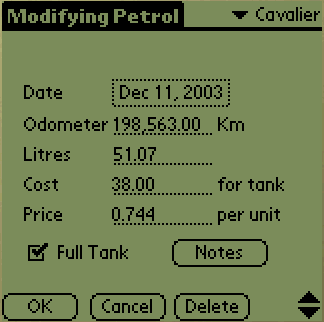
|
| Overall statistic form |
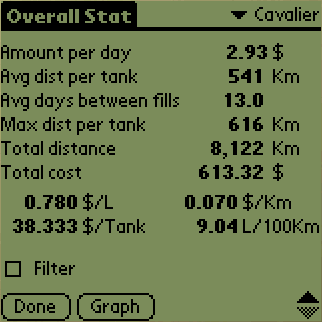
|
- Amount per day
-
This is the total amount spent on fuel from the first record to the
last record divided by the number of days between the first record to
the last.
]$_First,...,$_last] /(date_last - date_first). The $ value on the first
record is excluded.
- Avg dist per tank
-
This is the average distance done with a tank
(total_distance/(number_of_fills-1)).
- Avg days between fills
-
This is the average number of days between two record
(last_record.date - fist_record.date)/(number_of_fills-1)).
- Max dist per tank
-
This is the maximum distance between two record
(record_(i).odometer - record_(i-1).odometer).
When we traverse the list of record, the comparison is done againts the
current value only if record_(i) has its full tank checked.
- Total distance
-
This is the distance between the last record and the first record.
- Total cost
-
This is the total cost of all the record.
You can also include in the total cost the cost of the Maintenance item
for this car category. N.B. For now there is no feedback to tell you if
the maintenance cost is added or not so look at the number if it increase
when you select it in the menu.
(Figure Statistic form Menu)
- $/Volume
-
This is the total cost divided by the total volume put in the car.
The unit for the volume is the one defined in the
Preferences Form. This item does not include
the cost of the maintenance.
- $/Km
-
This is the total cost (including the maintenance cost if selected in the
preference) divided by the total distance.
The unit for the distance is the one defined in the
Preferences Form.
- $/Tank
-
This is the total cost (not including the maintenance cost) divided by
the number of record.
- L/100Km
- Here will be displayed the efficiency in the units chosen in the
Preferences Form.The value is calculated between
the first and the last full tank records.
| Statistic form Menu |
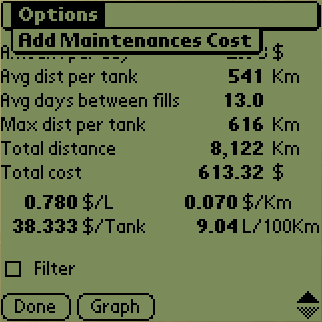
|
| Overall statistic form with filters |
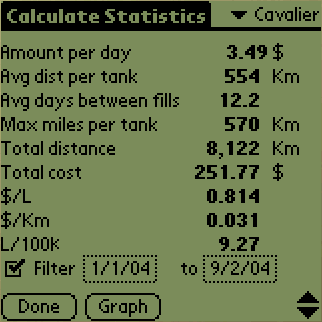
|
If you want to have the statistic for only a subset of the records you
can use the filters. When the filter checkbox is selected, two date
will appear. The first one indicates when should we start taking into
account the record and the second when is when to stop.
One utility for this can be to compare the difference in efficiency of
you car during the winter and summer. You can also check if the last
visit to the garage changed something.
| Statistics for a record |
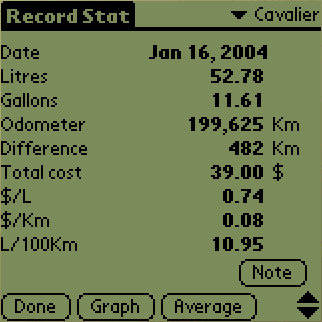
|
- $/Km
-
- Here will be displayed the $/distance in the units chosen in the
Preferences Form.The value is available only if this
record is a full tank and it is possible to find a full tank record in the
previous records.
- L/100Km
-
- Here will be displayed the efficiency in the units chosen in the
Preferences Form. The value is available only if this record
is a full tank and it is possible to find a full tank record in the previous records.
N.B.
When a filter is set (Fig. Overall
statistic form with filters) only the Stats for the records included by
the filter can be displayed.
When an individual record has a note. A note button will appear on the
stats form.
| Graphics of the efficiency |

|
| Graphics of the Price/Volume |
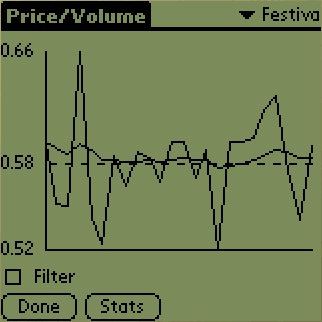
|
| Graphics Form Menu |
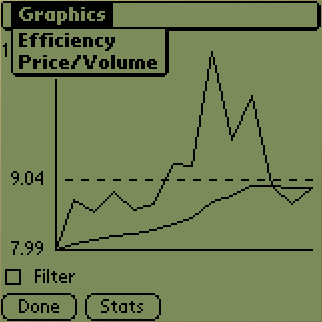
|
You can select the graph you want by going to the menu.
- Individual Readings
- This is the jaggy graph which plots the data you enter each time
you put fuel in the car. If you have a color display, it is red.
- Average line
- A line is draw across the graphs which represents average MPG. If you have a color display, it is green.
- Smoothed average
- The curve represents the smoothed average. It is blue, if you have a color display.
|




















